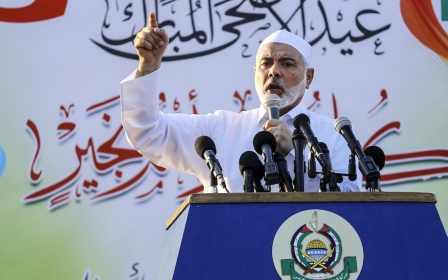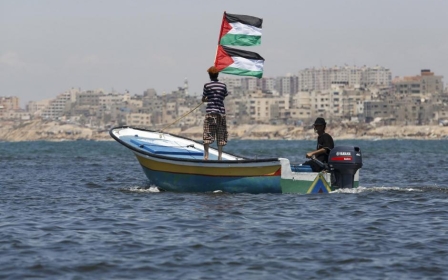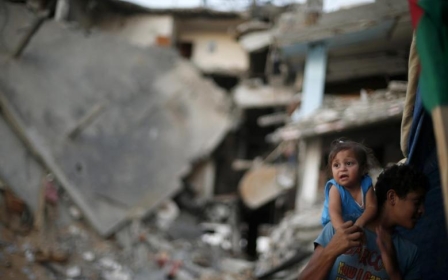Hamas has only the hudna to offer to lift the siege

Several months after the publication of my book Hamas: Unwritten Chapters (the US edition is titled Hamas: A History from Within), I was approached in the spring of 2008 by a think tank linked to a European government and asked to meet three former senior Israeli officials, who had apparently read my book, or parts of it, and were keen to learn more about the concept of hudna (armistice).
The three men included a former foreign minister, a former chief of staff and a former prime minister’s office manager. Several weeks after I gave a two-day, private seminar on the topic to the group in Europe, Israel and Hamas concluded their first official six-month truce deal. Brokered by the Egyptian government, it went into effect on 19 June 2008.
But Israel broke the truce on 4 November 2008 with an attack on a tunnel it claimed was intended for offensive purposes, a charge Hamas has always rejected. Rather than seize upon Hamas’s declared willingness to return to the truce agreement, Israel waged its major Operation Cast Lead offensive, which lasted until late January 2009.
Major offensives
Since then, Israel has embarked on two other major offensives, in addition to numerous lighter exchanges and incursions. On 14 November 2012, an Israeli air strike killed Ahmad al-Jaabari, chief of the Hamas military wing in Gaza. This was followed by an operation that Israel called Operation Pillar of Defence, codenamed by Hamas as Operation Stones of Baked Clay. After days of negotiations between Hamas and Israel, a ceasefire mediated by Egypt was announced on 21 November.
Then, on 8 July 2014, Israel launched Operation Protective Edge, one of its longest and deadliest military offensives against the Gaza Strip in recent history. The conflict lasted until 26 August 2014, killing 2,251 people, wounding more than 11,000 and causing massive destruction to Gaza’s civilian infrastructure.
Israel’s aim of destroying, or at least disarming, Hamas repeatedly failed, and a truce negotiated by Egypt was how every one of these major Israeli offensives came to an end
Israel’s aim of destroying, or at least disarming, Hamas repeatedly failed, and a truce negotiated by Egypt was how every one of these major Israeli offensives came to an end.
Today, Hamas is once again negotiating with Israel, through Egyptian brokerage, for a truce aimed at ending the violence and easing the Israeli-Egyptian blockade of Gaza. There has been some speculation that the new Egyptian mediation is a US requirement for the implementation of President Donald Trump’s son-in-law’s plan for Middle East peace, the “deal of the century”.
But Hamas leaders deny that the current talks in Cairo have anything to do with Jared Kushner’s plan. They believe Israel has been motivated by the weekly Great March of Return rallies in Gaza, along with the new tactic of scorching farmlands on the other side of the fence - which Palestinians in Gaza view as their ancestral occupied land - using kites and balloons, in retaliation for Israeli sniper fire, which has claimed dozens of lives and injured thousands of peaceful Palestinian protesters.
Mutual dislike and mistrust
What is extraordinary about this round of negotiations is that the only party that seems vehemently opposed to any truce deal between Hamas and Israel, which could lead to a lifting of the blockade, is the Ramallah-based Palestinian Authority (PA). President Mahmoud Abbas first wants Hamas to surrender the strip back to his authority. He wants any business with Israel to be his own prerogative, and he firmly believes that the blockade on Gaza is the only tool through which he can force Hamas to acquiesce.
Despite their dislike for Hamas, the Egyptians seem eager to achieve success in their brokered deal. Yet, although mutual dislike and mistrust characterises their relationship, both sides need each other. The main issue for Hamas involves lifting, or at least easing, the blockade, while for Egypt, it concerns security in northern Sinai.
Dahlan is Egypt’s favourite in any future contest for a Ramallah succession. Ironically, Hamas, or at least part of it inside Gaza, seems to have no issue with Dahlan, especially after revelations of Abbas’s role in imposing painful sanctions on Gaza.
The irony does not end there. The blow dealt to the two-state solution, by the combination of a right-wing government in Israel and a right-wing president in the White House, has inevitably revived the notion of an interim solution not based on mutual recognition but, as opposed to the two-state solution, predicated on the concept of mutual recognition and exchanging land for peace.
While there is no sufficiently credible or powerful Israeli left to fight for a two-state solution, those who believed in such a solution on the Palestinian side have either been disillusioned and given up, or been integrated into the Israeli occupation apparatus and are now perceived by Palestinians as Israeli lackeys.
What is extraordinary about this round of negotiations is that the only party that seems vehemently opposed to any truce deal between Hamas and Israel, which could lead to a lifting of the blockade, is the Ramallah-based Palestinian Authority (PA)
For many Palestinians, mutual recognition has turned out to be nothing but an endorsement of occupation. Evidently, a quarter of a century after the Oslo deal was signed, not much Palestinian land is left to support the creation of a Palestinian state.
The failure, thus far, to reconcile differences between Hamas and Fatah and reunite the Gaza Strip and the West Bank has left the Palestinians with two bickering, even conflicting, authorities in two detached entities.
While Israel is guaranteed peace and security in the West Bank through the collaboration of the Fatah-dominated Palestinian Authority, a Hamas-dominated Gaza remains a source of continuous headache.
Forced to do business
This leaves Israel with no choice but to deal with Hamas. Neither side would recognise the right of the other to exist, but neither is able to force the other to disappear, so both are forced to acknowledge the de facto existence of each other. Israel exists in much of historic Palestine while Hamas exists in the world’s most densely populated coastal enclave.
And so long as neither side is able to settle the conflict on its own terms, they will have no option but to do business together, and that business can have only one format, hudna - a formula that requires neither party to recognise the de jure existence of the other. It has proven to be handy.
The idea, as I explain in detail in my book, originated in the early 90s. It was referenced by the Amman-based former head of the Hamas political bureau, Musa Abu Marzuq, in a statement published by the Amman weekly Al-Sabeel in February 1994. A similar first reference to it inside Palestine was made around the same time by Hamas founder Sheikh Ahmed Yassin from his prison cell.
Yassin proposed hudna as an interim solution to the Israeli-Palestinian conflict. His proposal came in response to an Israeli request for intervention on his part with Hamas, to stop its newly adopted tactic, the martyrdom operation, to which it resorted in retaliation for the February 1994 massacre of Muslim worshippers at the Ibrahimi Mosque in Hebron.
The Israelis have persistently claimed, officially, that they do not pay much attention to the hudna proposal. Yet, as I noted earlier, there has been evident interest in the subject, and not just by the aforementioned former officials.
Over a period of at least four years, from 2010 until the military coup in Egypt in 2013, Israeli Prime Minister Benjamin Netanyahu despatched a personal representative to regular meetings in Europe with individuals linked to the Hamas leadership in Doha and Gaza to explore options for a long-term truce deal and a prisoner-exchange deal.
Increasing vulnerability
When Egyptian President Mohamed Morsi was still in power, the right-wing Netanyahu government searched for a backchannel to communicate with Morsi’s office and with Hamas. Netanyahu’s envoy to Europe might have succeeded in getting there, had it not been for the military coup that removed Morsi from office and ended not only the Egyptian quest for democracy, but also the Israeli need for a backchannel.
The Israelis and their partners tightened their grip on Gaza, in hopes of squeezing Hamas out or bringing it to its knees
The military coup of the Egyptian general Abdel Fattah al-Sisi relieved the Israelis and assured them that their own friends were once again in control of Egypt. As a consequence, Hamas lost a substantial amount of its regional backing and became increasingly vulnerable. Saudi Arabia and the UAE treated the movement with animosity while Iran called off much of its financial aid to Gaza to punish Hamas for deserting Syria. As the Arab Spring faded away, the movement became increasingly vulnerable.
So the Israelis and their partners tightened their grip on Gaza, in hopes of squeezing Hamas out or bringing it to its knees.
Whether it is the "deal of the century" or anxiety over the likelihood that Gaza might just explode in their faces, both the Egyptians and the Israelis are now seeking an understanding with Hamas. The marathon talks in Cairo are believed to be aimed at securing the area and avoiding another flare-up.
In a recent appearance with me on Alhiwar TV channel, the former head of Hamas Khalid Mishaal told me that his movement has only one thing to offer: hudna (truce) in exchange for lifting the siege. Yet there may be other issues on the table, including a prisoners’ exchange.
- Azzam Tamimi is a British Palestinian academic and political activist.
The views expressed in this article belong to the author and do not necessarily reflect the editorial policy of Middle East Eye.
Photo: A member of Hamas’s military police walks through the site of Israeli air strikes in Gaza City on 9 August (AFP)
This article is available in French on Middle East Eye French edition.
Stay informed with MEE's newsletters
Sign up to get the latest alerts, insights and analysis, starting with Turkey Unpacked
Middle East Eye delivers independent and unrivalled coverage and analysis of the Middle East, North Africa and beyond. To learn more about republishing this content and the associated fees, please fill out this form. More about MEE can be found here.






